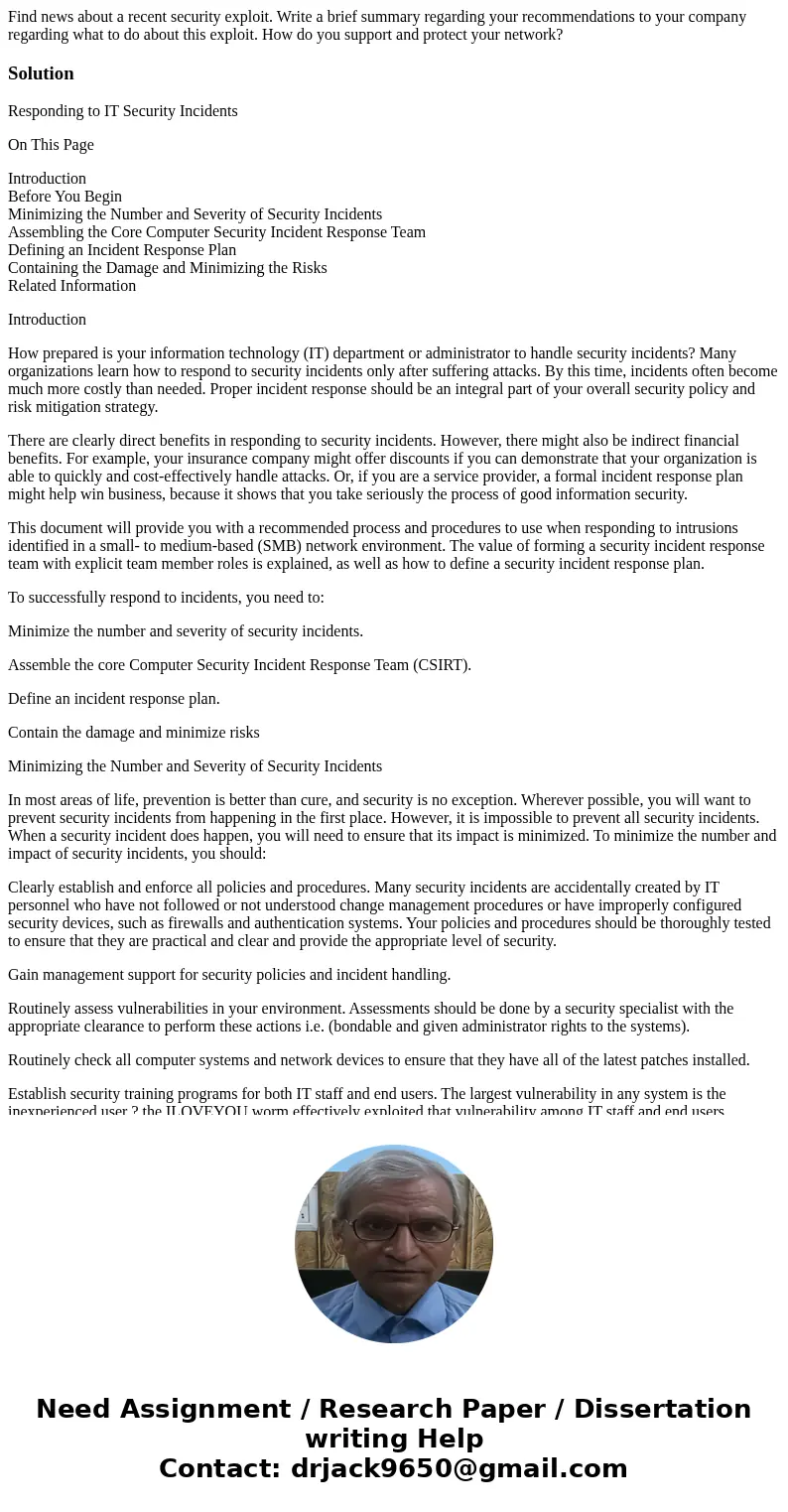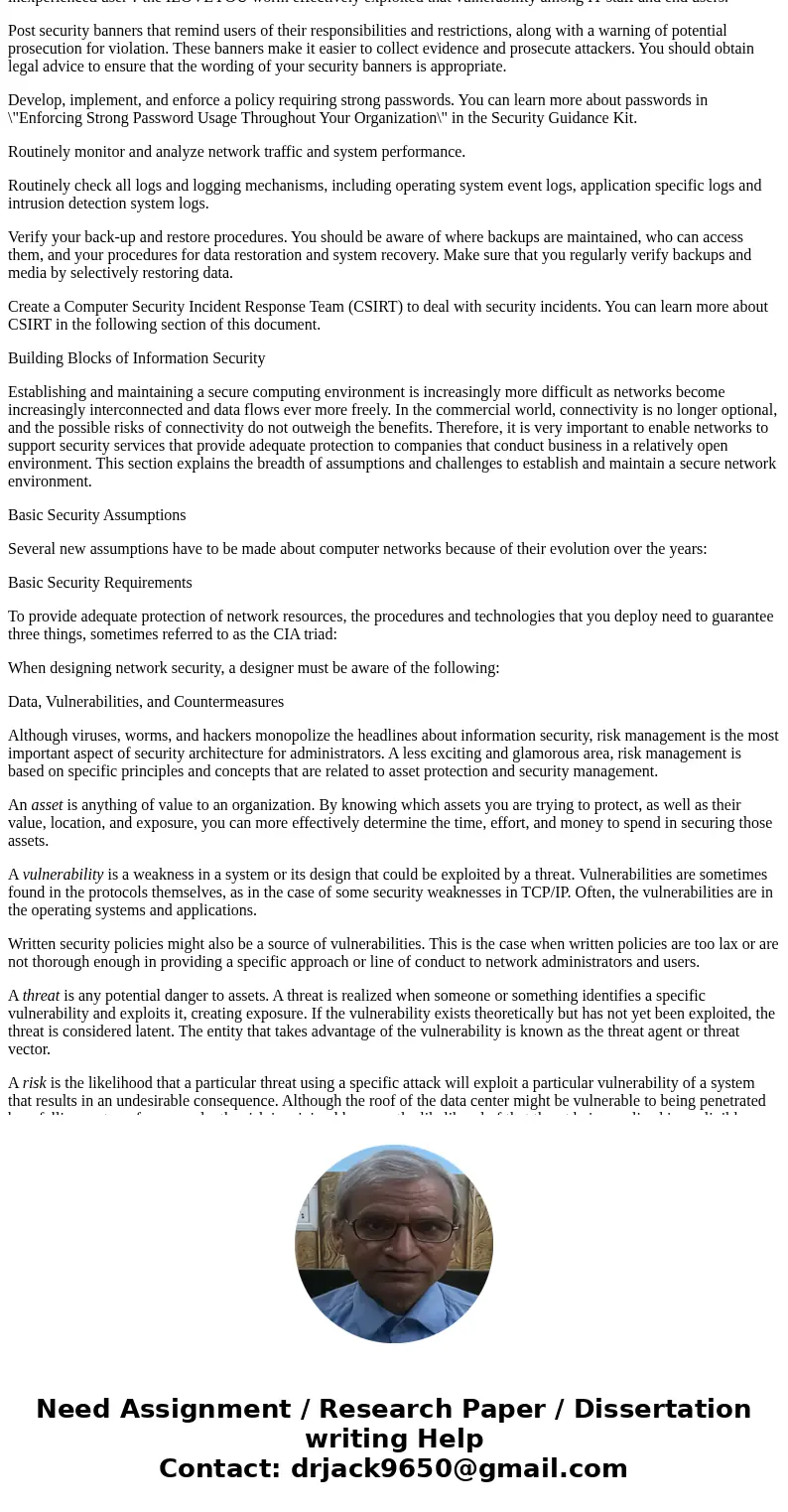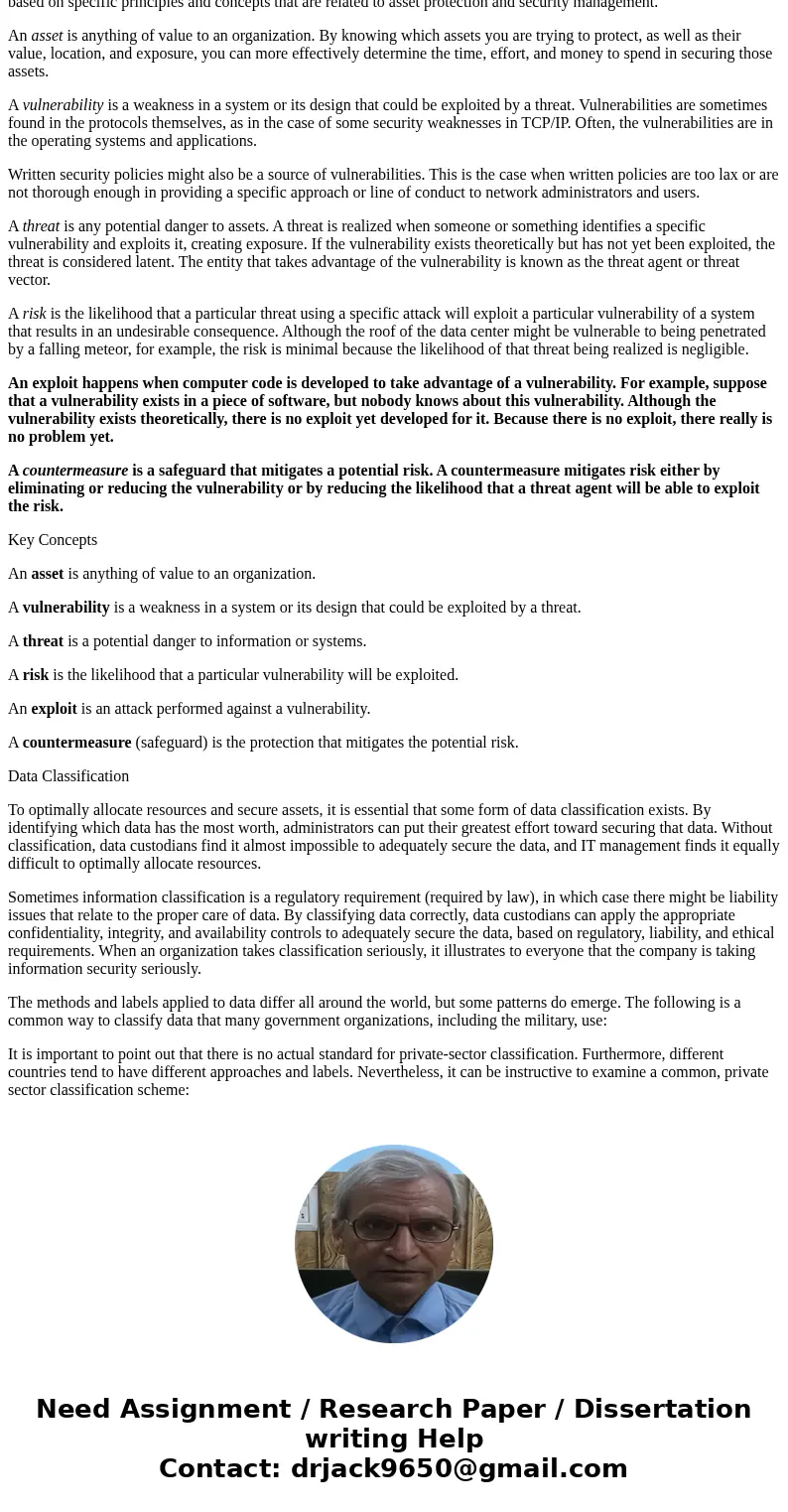Find news about a recent security exploit Write a brief summ
Find news about a recent security exploit. Write a brief summary regarding your recommendations to your company regarding what to do about this exploit. How do you support and protect your network?
Solution
Responding to IT Security Incidents
On This Page
Introduction
Before You Begin
Minimizing the Number and Severity of Security Incidents
Assembling the Core Computer Security Incident Response Team
Defining an Incident Response Plan
Containing the Damage and Minimizing the Risks
Related Information
Introduction
How prepared is your information technology (IT) department or administrator to handle security incidents? Many organizations learn how to respond to security incidents only after suffering attacks. By this time, incidents often become much more costly than needed. Proper incident response should be an integral part of your overall security policy and risk mitigation strategy.
There are clearly direct benefits in responding to security incidents. However, there might also be indirect financial benefits. For example, your insurance company might offer discounts if you can demonstrate that your organization is able to quickly and cost-effectively handle attacks. Or, if you are a service provider, a formal incident response plan might help win business, because it shows that you take seriously the process of good information security.
This document will provide you with a recommended process and procedures to use when responding to intrusions identified in a small- to medium-based (SMB) network environment. The value of forming a security incident response team with explicit team member roles is explained, as well as how to define a security incident response plan.
To successfully respond to incidents, you need to:
Minimize the number and severity of security incidents.
Assemble the core Computer Security Incident Response Team (CSIRT).
Define an incident response plan.
Contain the damage and minimize risks
Minimizing the Number and Severity of Security Incidents
In most areas of life, prevention is better than cure, and security is no exception. Wherever possible, you will want to prevent security incidents from happening in the first place. However, it is impossible to prevent all security incidents. When a security incident does happen, you will need to ensure that its impact is minimized. To minimize the number and impact of security incidents, you should:
Clearly establish and enforce all policies and procedures. Many security incidents are accidentally created by IT personnel who have not followed or not understood change management procedures or have improperly configured security devices, such as firewalls and authentication systems. Your policies and procedures should be thoroughly tested to ensure that they are practical and clear and provide the appropriate level of security.
Gain management support for security policies and incident handling.
Routinely assess vulnerabilities in your environment. Assessments should be done by a security specialist with the appropriate clearance to perform these actions i.e. (bondable and given administrator rights to the systems).
Routinely check all computer systems and network devices to ensure that they have all of the latest patches installed.
Establish security training programs for both IT staff and end users. The largest vulnerability in any system is the inexperienced user ? the ILOVEYOU worm effectively exploited that vulnerability among IT staff and end users.
Post security banners that remind users of their responsibilities and restrictions, along with a warning of potential prosecution for violation. These banners make it easier to collect evidence and prosecute attackers. You should obtain legal advice to ensure that the wording of your security banners is appropriate.
Develop, implement, and enforce a policy requiring strong passwords. You can learn more about passwords in \"Enforcing Strong Password Usage Throughout Your Organization\" in the Security Guidance Kit.
Routinely monitor and analyze network traffic and system performance.
Routinely check all logs and logging mechanisms, including operating system event logs, application specific logs and intrusion detection system logs.
Verify your back-up and restore procedures. You should be aware of where backups are maintained, who can access them, and your procedures for data restoration and system recovery. Make sure that you regularly verify backups and media by selectively restoring data.
Create a Computer Security Incident Response Team (CSIRT) to deal with security incidents. You can learn more about CSIRT in the following section of this document.
Building Blocks of Information Security
Establishing and maintaining a secure computing environment is increasingly more difficult as networks become increasingly interconnected and data flows ever more freely. In the commercial world, connectivity is no longer optional, and the possible risks of connectivity do not outweigh the benefits. Therefore, it is very important to enable networks to support security services that provide adequate protection to companies that conduct business in a relatively open environment. This section explains the breadth of assumptions and challenges to establish and maintain a secure network environment.
Basic Security Assumptions
Several new assumptions have to be made about computer networks because of their evolution over the years:
Basic Security Requirements
To provide adequate protection of network resources, the procedures and technologies that you deploy need to guarantee three things, sometimes referred to as the CIA triad:
When designing network security, a designer must be aware of the following:
Data, Vulnerabilities, and Countermeasures
Although viruses, worms, and hackers monopolize the headlines about information security, risk management is the most important aspect of security architecture for administrators. A less exciting and glamorous area, risk management is based on specific principles and concepts that are related to asset protection and security management.
An asset is anything of value to an organization. By knowing which assets you are trying to protect, as well as their value, location, and exposure, you can more effectively determine the time, effort, and money to spend in securing those assets.
A vulnerability is a weakness in a system or its design that could be exploited by a threat. Vulnerabilities are sometimes found in the protocols themselves, as in the case of some security weaknesses in TCP/IP. Often, the vulnerabilities are in the operating systems and applications.
Written security policies might also be a source of vulnerabilities. This is the case when written policies are too lax or are not thorough enough in providing a specific approach or line of conduct to network administrators and users.
A threat is any potential danger to assets. A threat is realized when someone or something identifies a specific vulnerability and exploits it, creating exposure. If the vulnerability exists theoretically but has not yet been exploited, the threat is considered latent. The entity that takes advantage of the vulnerability is known as the threat agent or threat vector.
A risk is the likelihood that a particular threat using a specific attack will exploit a particular vulnerability of a system that results in an undesirable consequence. Although the roof of the data center might be vulnerable to being penetrated by a falling meteor, for example, the risk is minimal because the likelihood of that threat being realized is negligible.
An exploit happens when computer code is developed to take advantage of a vulnerability. For example, suppose that a vulnerability exists in a piece of software, but nobody knows about this vulnerability. Although the vulnerability exists theoretically, there is no exploit yet developed for it. Because there is no exploit, there really is no problem yet.
A countermeasure is a safeguard that mitigates a potential risk. A countermeasure mitigates risk either by eliminating or reducing the vulnerability or by reducing the likelihood that a threat agent will be able to exploit the risk.
Key Concepts
An asset is anything of value to an organization.
A vulnerability is a weakness in a system or its design that could be exploited by a threat.
A threat is a potential danger to information or systems.
A risk is the likelihood that a particular vulnerability will be exploited.
An exploit is an attack performed against a vulnerability.
A countermeasure (safeguard) is the protection that mitigates the potential risk.
Data Classification
To optimally allocate resources and secure assets, it is essential that some form of data classification exists. By identifying which data has the most worth, administrators can put their greatest effort toward securing that data. Without classification, data custodians find it almost impossible to adequately secure the data, and IT management finds it equally difficult to optimally allocate resources.
Sometimes information classification is a regulatory requirement (required by law), in which case there might be liability issues that relate to the proper care of data. By classifying data correctly, data custodians can apply the appropriate confidentiality, integrity, and availability controls to adequately secure the data, based on regulatory, liability, and ethical requirements. When an organization takes classification seriously, it illustrates to everyone that the company is taking information security seriously.
The methods and labels applied to data differ all around the world, but some patterns do emerge. The following is a common way to classify data that many government organizations, including the military, use:
It is important to point out that there is no actual standard for private-sector classification. Furthermore, different countries tend to have different approaches and labels. Nevertheless, it can be instructive to examine a common, private sector classification scheme:



 Homework Sourse
Homework Sourse